Recurring revenue from a membership site is a reliable way to create a stable, predictable income akin to a salary while preserving the freedom, flexibility, and financial reward of owning your own businesses.
In this blog, you’ll learn about:
- Pricing models
- Pricing 101: The classic optimization problem
- How to determine optimal pricing for your membership site
- Membership pricing do’s and don’ts
Many membership entrepreneurs start their business with a revenue target and back into a monthly subscriber goal by dividing monthly revenue by a price that sounds “reasonable.” Perhaps you’ve seen this math on social media or ads: “If you want to earn $100,000 a year, you only need 416 subscribers paying you $20/month or 832 subscribers paying you $10/month!”
While the math is right, starting with a revenue goal in mind is backward. You can calculate any subscription price and any subscriber count to generate any amount of revenue.
It’s all theoretical until you have a real problem you’re solving that members are willing to pay to have solved through a membership. Only then can you set a revenue-maximizing price.
Using the above example, what if your membership solution is so good that the 832 subscribers who would happily pay $10/month are actually willing to pay you $30, $40, or even $50/month? Or, what if there are 10,000 subscribers willing to pay if you priced at $5/month?
If you start with a revenue goal in mind and back into a target membership price, you could miss your target or, worse, you could leave significant income on the table.
Pricing is one of the most important decisions you’ll make for your membership site, but it actually comes third in importance. Before you can set a price, you must first:
- Determine the problem you are solving and your target market
- Decide how you will solve the problem through a membership site
This deep dive on how to create a membership site goes in-depth into steps 1 and 2, which must be established before you can set a price. Once you know the problem you are solving and have validated how it can be solved through a membership site, you’re ready to read on and find your pricing sweet spot.
Pricing Models
Before you dive deep into your pricing, you’ll need to decide whether the solution you’ve created to solve your target market’s problem calls for a one-time payment, a recurring payment, or a combination of both.
One-Time Payment
A one-time payment is best if your solution does not require you to provide ongoing content, support, and delivery. For example, you may charge a one-time fee for access to a fixed-duration course and low-maintenance community.
However, if your solution requires you to provide ongoing training, new content, and support without a fixed endpoint, you’re better off charging a recurring membership subscription.
Recurring Payment
A recurring payment is a monthly or annual subscription for ongoing access to your solution. This is best if your solution requires you to provide continuous training or ongoing access to a service. Most membership sites are based on recurring payments.
Not only does a recurring payment provide you with ongoing income, but also it allows you to amortize your customer acquisition cost over time. It’s much less expensive to keep an existing member happy than it is to find a new member.
Hybrid
Some membership sites charge a higher one-time payment upfront with a less expensive, recurring monthly payment after.
This model works well if members are provided with substantial value upfront, such as access to a course, with ongoing training and support building off of the course’s teachings.
Other Models to Consider
- Freemium: Some entrepreneurs offer access to a free membership with basic value and a separate, paid membership area with more advanced content or additional value. If you offer a freemium model, make sure your free offering is valuable enough to suggest there is even more value in your paid offering. If your free offering is high quality by your target market’s standards, your members will have more confidence to enroll in your paid solution.
- Membership Tiers: If your solution lends itself to different levels of support, you may be able to offer a lower-priced and a higher-priced paid membership tier. For example, a lower-priced tier may offer DIY solutions while a higher-priced tier may offer personal consulting time from you, the site owner, as well as a done-for-you, customized solution. “Free” may be one of your membership tiers. More than three tiers can be confusing to prospective members.
Pricing 101: the classic optimization problem
When setting your membership price, you are solving a classic economic optimization problem: What is the revenue-maximizing price?
If you want to skip ahead for the “how-to,” go ahead and click to the next section. However, if you want to understand the real economics of a membership site, read on.
You may recall the standard economic demand curve from high school or college economics:
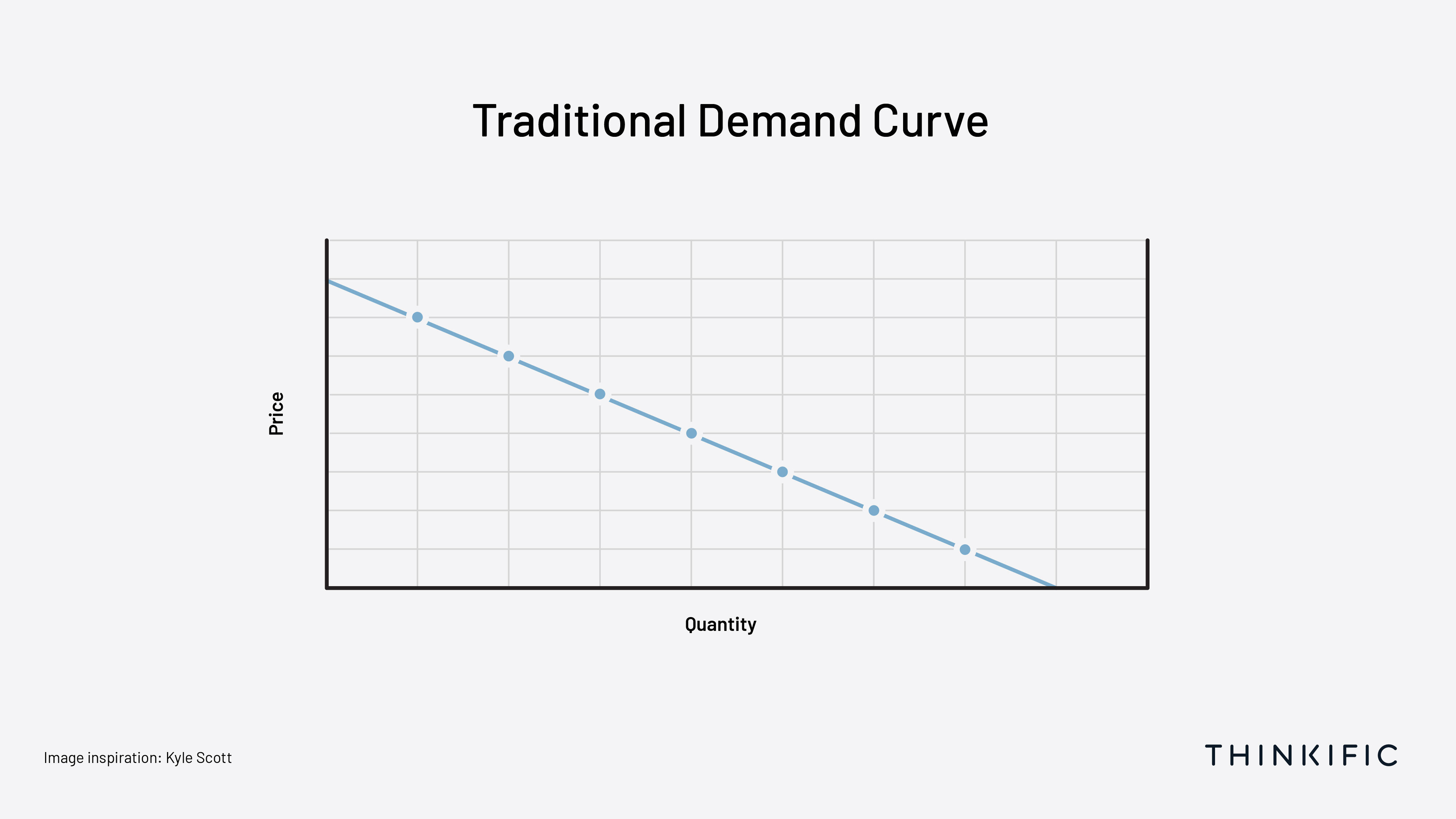
For a traditional product, fewer units are demanded at a higher price and more units are demanded at a lower price. To calculate the revenue-maximizing price, you’d solve for the “area under the curve,” multiplying price by quantity at each price point until you find the revenue-maximizing combination of price and quantity.
By plotting revenue on the demand curve, you’ll find monthly revenue is maximized at the quantity where the revenue curve is the highest:
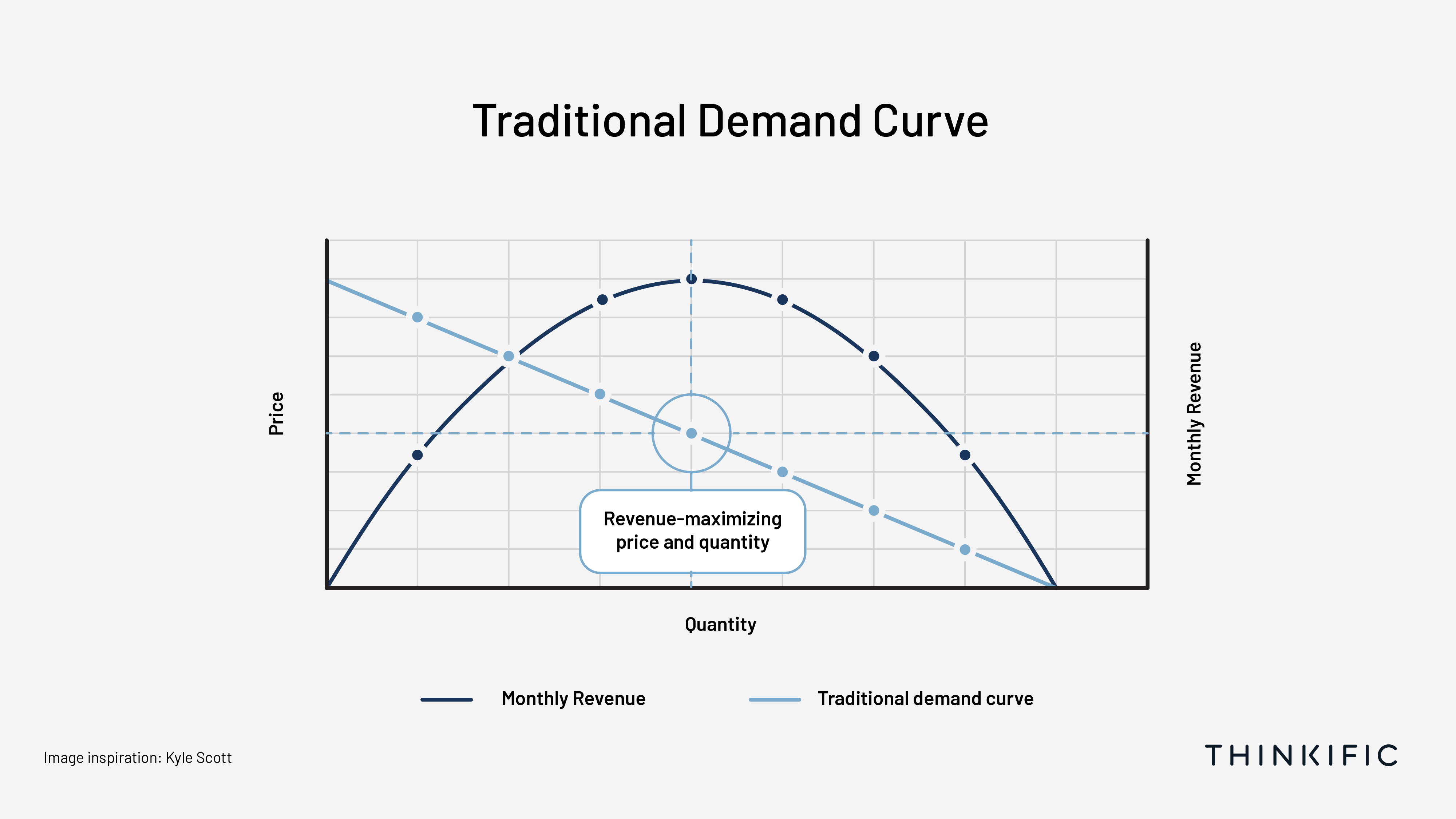
A membership site’s demand curve looks like this:
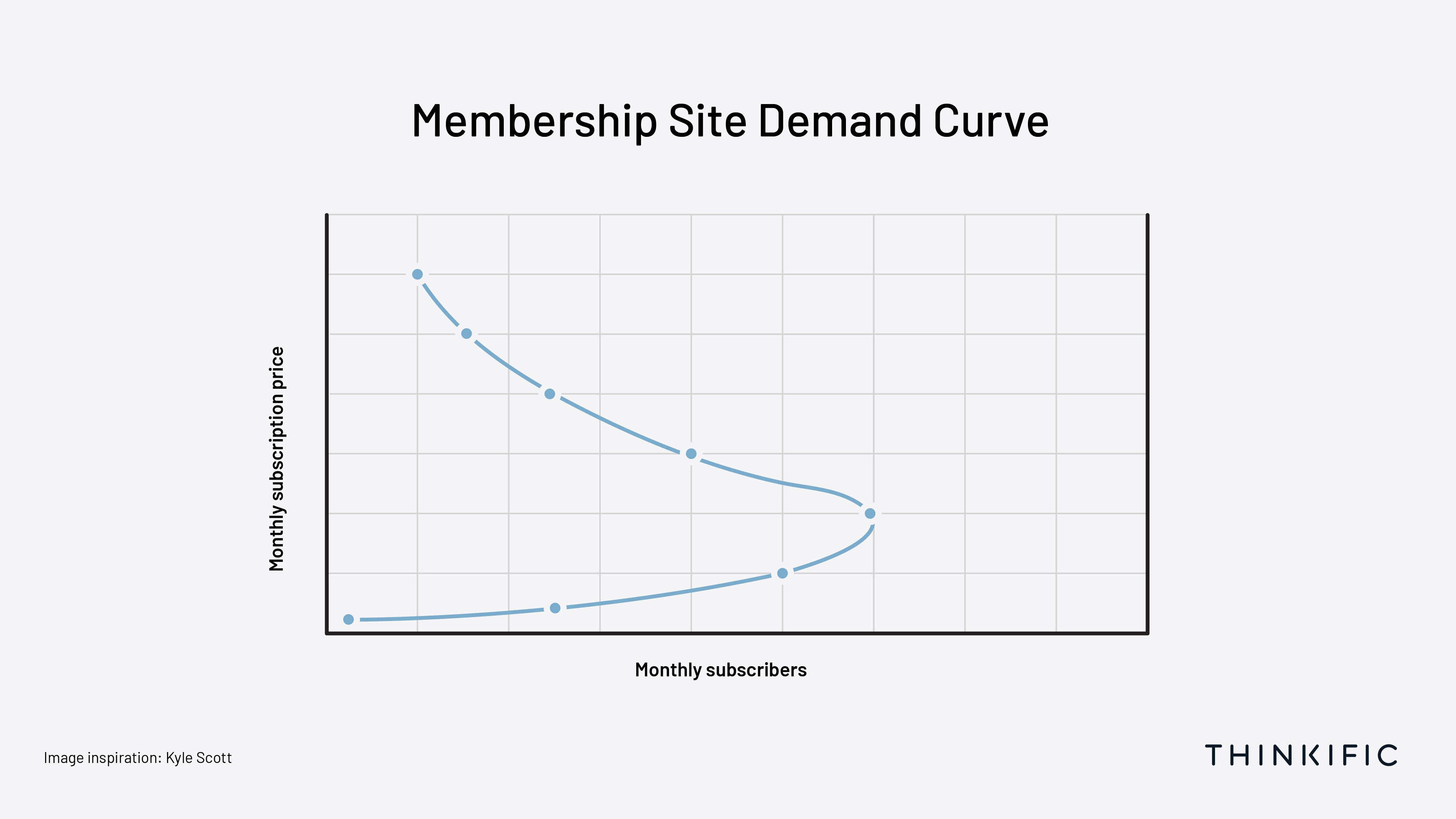
If you price too low, you’ll have too few subscribers because your membership will be perceived as lacking value. This of it this way: If a car is selling for only $4,000, there must be something wrong with it, right?
If you price too high, you’ll have too few subscribers with the willingness to pay.
This is the visual representation of the revenue-maximizing price using the above demand curve:
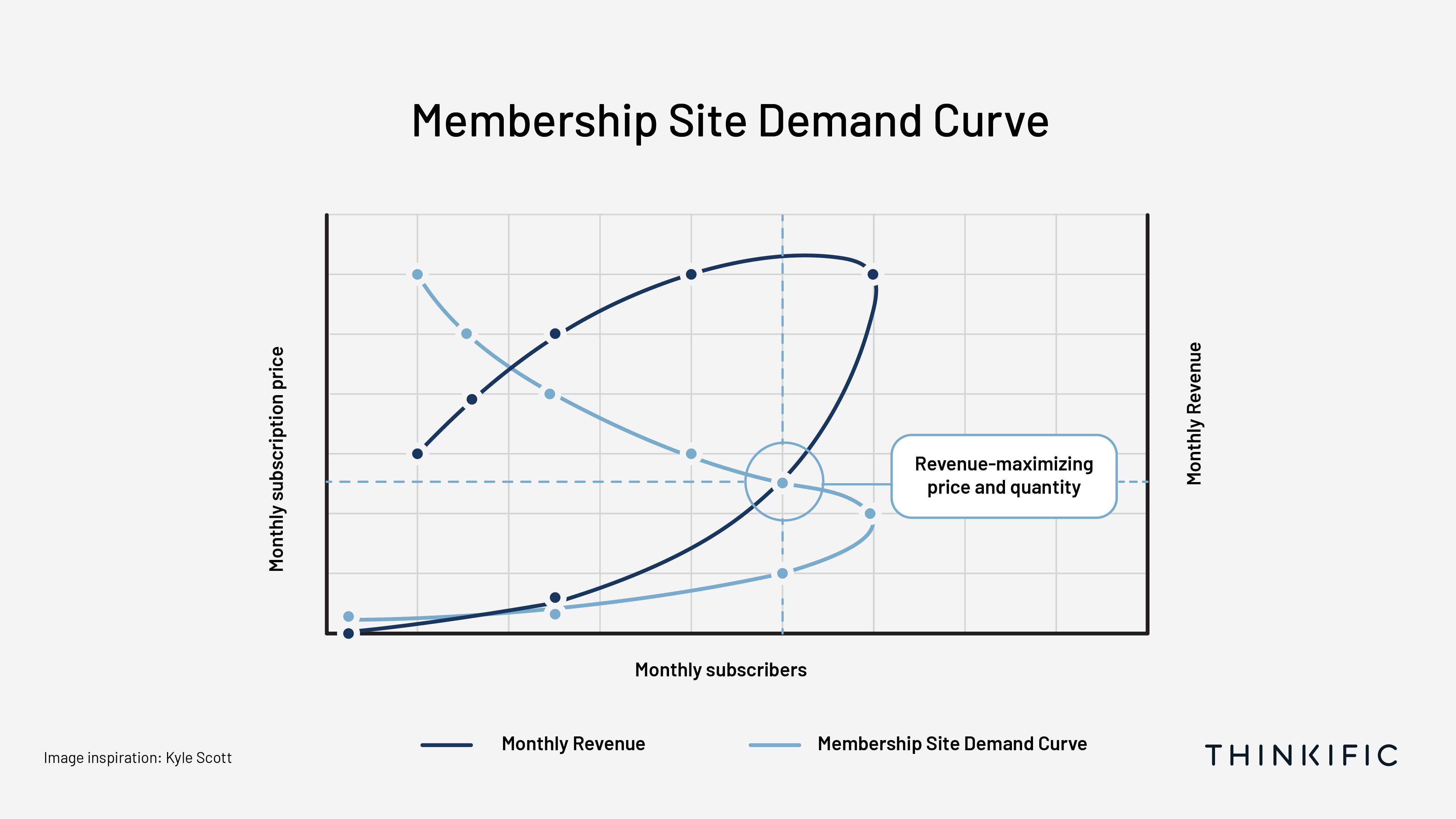
In a perfect world, you’d know the equation for your demand curve, and you can set the exact revenue-maximizing price for your membership. Unless you’re willing to hire an economist to do market research and discover the most likely revenue-maximizing price, you’ll have to make a best estimate for your membership pricing sweet spot.
How to determine optimal pricing for your membership site
If you’ve followed the advice for getting started with your membership site, you’ve already identified (1) the problem you’re solving and your target market; and (2) you’ve decided how to solve the problem through a membership site.
At this point, you have enough information about your intended offering to find competitors with similar solutions. Their prices will ground your target market’s ballpark for an acceptable price.
Create a list of your competitors’ offerings, prices, and a rough estimate of their membership size, and the number of years in business. You’ll need some of these figures in Step 2.
To review your competitors, use this table as a guide or grab our Membership Site Competitor Review Excel Template.
| Competitor | Member Benefits | Monthly Price | Annual Price (if applicable) | % Annual Discount (if applicable) | Estimate of membership size | Estimate of years to grow to current membership size |
| The Budget Maven | One 30-minute webinar/week Monthly newsletter Quarterly personal budget review Private FB community | $10/mo | $99/yr | 20% | 1,000 members | 3 years |
Armed with a competitive ballpark for assumptions, move on to the next step: Calculating Your Rough Pricing Floor.
Pricing Step 2: Calculate Your Rough Pricing Floor
Next, you’ll need to estimate your monthly per-member cost for providing the membership solution you’ve devised. This will be your pricing floor. Pricing below your per-member cost will cause you to lose money.
There are two costs to consider: Variable and Fixed.
Variable costs
Variable costs are expenses directly associated with each additional member who subscribes to your site. Variable costs might include:
- Transaction processing fees (e.g. Stripe or PayPal fees)
- Sales commissions (if you have a sales team)
- Consulting hours (e.g. if you provide a consulting service of X hours for each member and have a value to place on your time)
Fixed costs
Fixed costs are expenses you incur regardless of your subscriber count. These include:
- Software subscriptions
- Advertising expenses
- Content-related expenses to feed your membership
- Employee salaries
Whether to include a salary for yourself as a fixed cost is up to your personal needs and business goals. Some entrepreneurs will include paying themselves as a necessary part of the business while others prefer to view their personal income as profit after costs are considered.
Keep in mind the more members you have, the more you can spread your fixed costs out among each member.
To calculate your rough break-even monthly membership price, make three assumptions:
- Per-member monthly variable costs.
- The projected number of members you’ll have paying for your monthly membership at the end of your first year. Use your competitive research to estimate. Divide your competition’s estimated membership size by number of years in business for an approximation of your competition’s membership growth per year. Adjust this number down by as much as 50%, as many membership sites accelerate annual growth as they demonstrate results. Adjust your projection as you see fit.
- Total monthly fixed costs for delivering your intended solution.
Now, calculate your rough break-even pricing floor as follows:
- Determine your monthly per-member fixed cost allocation by dividing monthly fixed costs by your target number of members at the end of your first year.
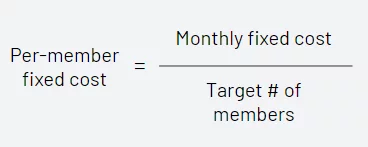
- Add your monthly per-member variable cost to your monthly per-member fixed cost allocation.

The result is your rough monthly pricing floor. Pricing below this number will cause you to lose money.
Remember, the accuracy of your monthly pricing floor is only as good as your assumptions. Do not view your estimate as anything more than a ballpark figure.
Pricing Step 3: Pricing Floor Sanity Check
Compare your estimated pricing floor to your competition. Are you in a similar ballpark?
When evaluating your pricing floor as compared to your competition, remember your competition’s public-facing prices have profit margin built-in. If you didn’t add a salary for yourself as a fixed cost in Step 2, add the desired profit margin into your pricing floor here.
How does your per-member pricing floor plus desired per-member profit margin compare to your competition’s prices?
If your pricing floor plus profit margin is well above your competition’s prices, consider whether you can command a premium in your market or, if not, whether your target market is willing to pay for your more expensive solution.
Pricing Step 4: Set Your Initial Price
Now it’s time to set your initial price! Consider these strategies:
- Cost plus profit margin: This is one of the most common ways retail businesses set prices, and it’s also one of the simplest. If you’ve followed these steps, you’ve already calculated the price using this method in Steps 2 and 3. The challenge with this pricing strategy is it ignores consumer demand (refer to the Pricing 101 section of this article if you haven’t already), and the value from your membership to your members might be much more than the cost plus a standard profit margin.
- Charge roughly what your competitors charge: You studied your competition’s prices in Step 1. This is an easy pricing model because your competition has already told you how the market responds at this price. However, this pricing model doesn’t take into account your solution. Is it a more valuable solution than your competition’s? Or, is it simpler than your competition’s solution, and you could actually make more money off of a higher volume by pricing lower? Or, do you want to undercut your competition to gain market share and raise prices once you’ve proven your value in the market?
- ROI to your members: You may be able to calculate ROI to your members from learning and implementing your solution. Price based on expected ROI. With this pricing strategy, you may consider offering a form of money-back guarantee if your member doesn’t achieve the expected ROI. Be clear upfront with what a member needs to do to qualify for a money-back guarantee.
- Market research: Survey your target market to understand their willingness to pay for your solution. If you use strategy, remember there may be bias in your responses, and participants may tell you what they think you want to hear. This method is best used to sanity check a high price to see if it will be rejected rather than if the high price will be accepted.
- Your desired position in the market: Price can be used as a marketing tool. If your membership solution is a high-end offering, or your solution is unique or rare, your pricing should reflect these qualities.
In practice, you’ll likely use a combination of all five strategies to set your initial price.
Here’s another strategy to think about pricing from Melissa Guller, Founder, Wit & Wire—the three pricing levers:
- Increasing the Significance of the Outcome
Ideally, the outcome should be urgent and important to the buyer, and it should be tied to one of the big three categories: health, wealth, or relationships
- Increasing the Buyer’s Certainty
The more certain the buyer is that your offer will help them reach their outcome, the more they will be willing to pay (case studies, testimonials etc).
- Decreasing the Buyer’s Spend
This is how much time, money, or resources they would have to spend to reach their goal. This lever can be pulled by decreasing the amount of time, money, or resources the buyer has to spend to reach their goal.
Membership pricing do’s and don’ts
| Do | Don’t |
| Determine the problem you’re solving for your target market and your solution before you set your price. Study your competition. Be ready to adjust your price based on new information after you enter your market. Have the confidence to price based on the value you’re providing. Value your time, either as a fixed cost of your business or as profit after expenses. | Price based exclusively on revenue goals. Price without understanding your variable and fixed costs – that’s a fast way to lose money! Make pricing assumptions based on what you or your immediate circle of friends would be willing to pay. Make your pricing complicated. |
The Final Word on Pricing
Even if you had an economist on your staff to produce the perfect, real-time demand curve for your membership site, pricing is more of an art than a science. Compelling marketing and an all-star sales team can effectively sell a membership site that’s priced too high on its face. Conversely, under-investment in marketing and a poor sales process can limit growth of a well-priced membership site.
Finally, there is the overarching question of business strategy.
What is the purpose of your membership site? How does it fit into the rest of your business, or is it your entire business? If your membership site is a cash cow to support your lifestyle, you may choose a price that provides you just enough income to support yourself with fewer, less-demanding customers. If you aspire for long-term growth, and you have cash reserves to invest in your business, you might underprice now to build a following, grandfather in your first members at a lower price point, and charge new members a higher price once you’ve gained market share.
The pricing possibilities are endless. Don’t overthink it, and, remember, price is just one part of your membership site. Membership value comes first.
This blog was published in February 2021 and was updated March 2023 to be even more useful.
Want to learn more about pricing? Here’s how to price your course:
This post was originally published in February 2021. It was updated in August of 2023 with more information.







